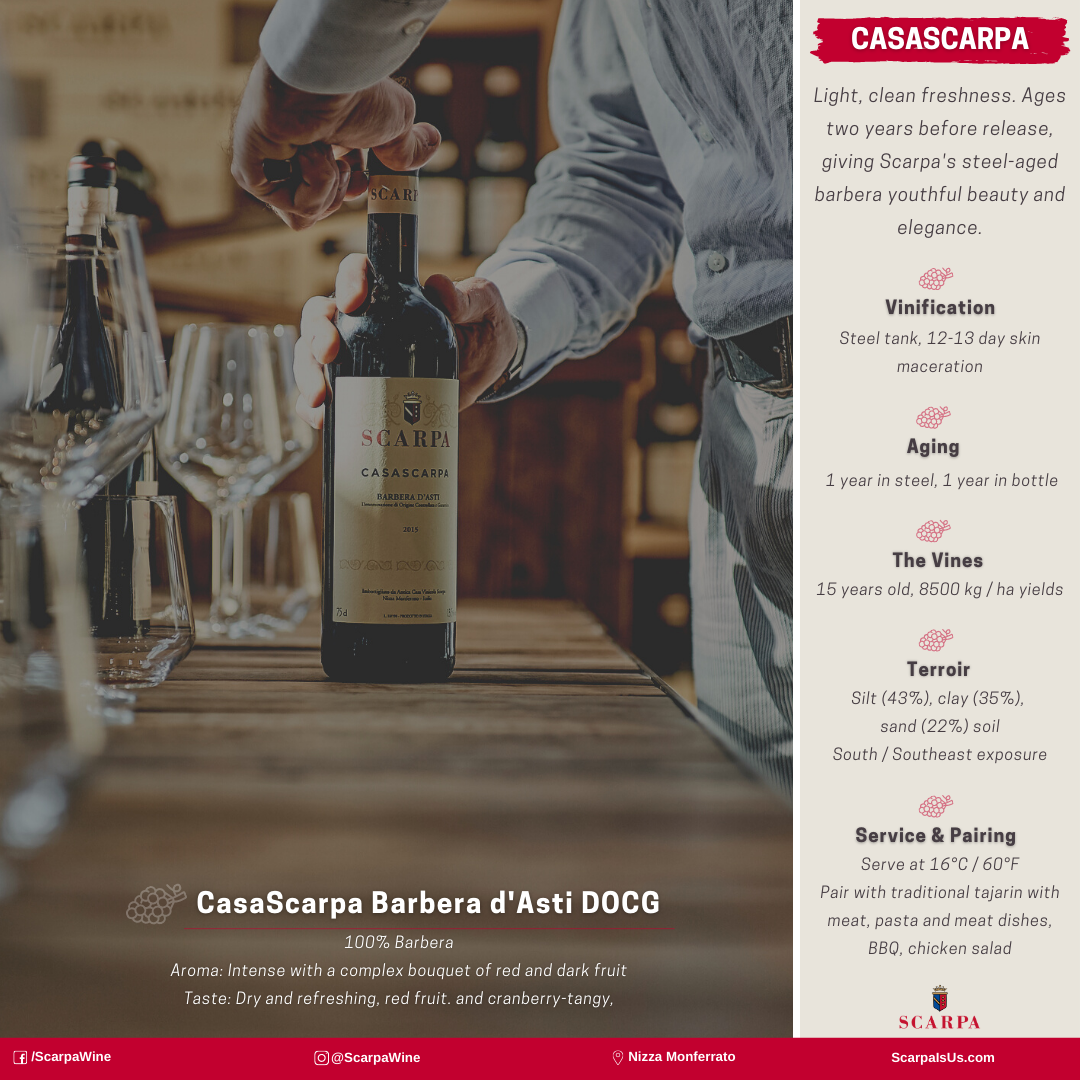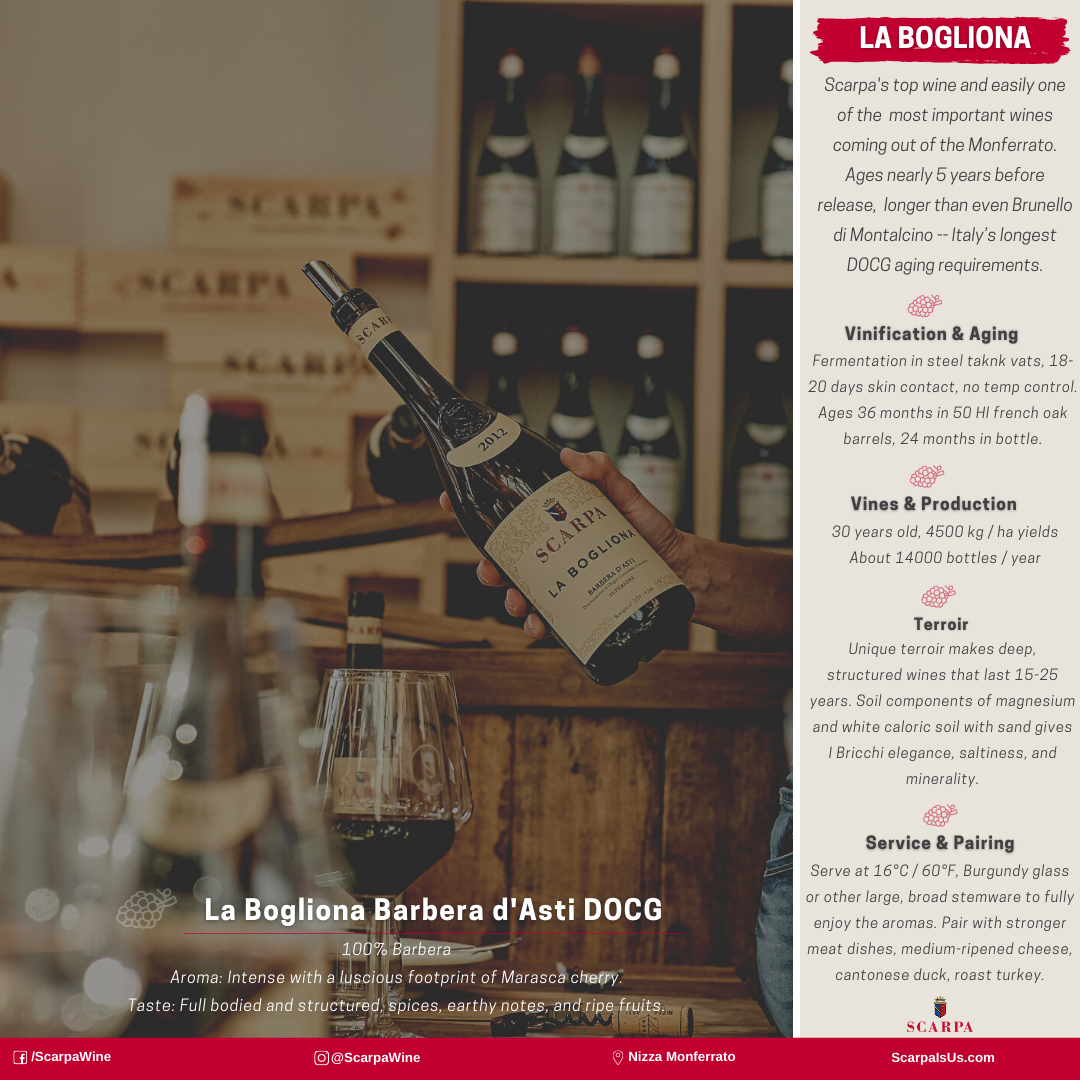Ready to get deeper into your barbera wine education? Next up: your guide to the top Monferrato wine, Barbera d’Asti. We’ve got all you need to know about styles, production, and Barbera d’Asti wine DOCG requirements.
In our first piece on barbera wine, we took a broad look at the barbera grape and the resulting wine. Now, let’s focus a little more closely on its land of origin: the Monferrato wine region.
The Monferrato in Northern Italy’s Piedmont region sits about 60 km (37 miles) east of Turin and 100 km (62 miles) south-west from Milan. It’s on the right bank of the River Po where the river runs at the foot of the Monferrato hills.
Scarpa Winery: A Monferrato Wine Pioneer
The historic Scarpa winery is located in southwestern Piedmont, producing traditional wines from the area’s indigenous grape varieties – from barbera and nebbiolo to lesser-known varieties like freisa and brachetto. Since the 1900s, Scarpa’s traditional wine making approach has been anchored in a deep respect for its land and terroir. The magic in these wines happens in the vineyards – not the cellar. Scarpa produces the most important wines of the area, cultivated from the best vineyard sites. The winery adheres to strict sustainable farming practices, giving the Scarpa wines natural balance and harmony.
To read more about Scarpa’s commitment to Sustainability in wine.
Click here.
The Monferrato wine region
With an average of 2000 hours (nearly 84 days) of sun annually, combined with a gentle, mild, and dry climate the Monferrato wine region is optimal for grape cultivation. Recordings of the grape date back to the 16th century.
While there are a few main elements, soil is the primary component that dictates Barbera d’Asti wine styles. The northern territory’s more calcareous soils gives these Barbera d’Asti wines deeper color and more power. Monferrato’s south has sandier soil, making lighter and easier drinking Barbera d’Asti wines.
Barbera d’Asti: What is the ‘d’Asti meaning?”
The ‘d’asti’ meaning simply tells you that the grapes are grown and the wine is produced in the hilly area of the province of Asti (67 municipalities) and Alessandria (51 municipalities).
The d’Asti meaning took on a greater significance in 1970 with the granting of DOC status. That was further elevated in 2008 when Barbera d’Asti wines were granted DOCG status.

Barbera d’Asti wine: Understanding the label
In Italy, DOCG status is coveted, branding it one of Italy’s best wines. While to most wine lovers the DOCG fascetta represents best in class, for wine producers it means a whole set of rules and regulations to ensure that the labels that bear the varietal or regional name are adhering to the strictest of protocols. Why? To ensure quality.
So, let’s try to break it down.
Our Barbera D’Asti DOCG visual above gives you the technical details. But, let’s briefly summarize what exactly is in your glass.
- Barbera d’Asti DOCG and Barbera d’Asti DOCG Superiore may use a single vineyard or vigna name on the label to recognize a specific subzone or top cru.
- Barbera d’Asti DOCG Superiore requires at least 6 months of wood aging. The thing to note here is that the practice is used for juice with more potential for complexity (older vines, grapes grown in more calcareous soil, etc). The wood aging – type is at the discretion of the producer (barrel, tonneaux, botti grande) – builds up tannin and structure.
- Fresh, younger drinking steel-aged Barbera d’Asti wines (solo acciaio) require a minimum of 4 months cellar aging. You will never find a steel-aged Barbera d’Asti wine labeled Superiore. Don’t be fooled by the lack of wood. Well grown steel-aged Barbera d’Asti wines can last up to 8 years giving ethereal beauty and depth. In fact, Scarpa’s steel-aged Casa Scarpa Barbera d’Asti DOCG doesn’t even release until two years after harvest and ages with beautiful elegant notes.
- Barbera d’Asti DOCG requirements dictate 90 percent use of barbera grapes with 10 percent non-aromatic red wine grapes allowed. However, today most producers use 100 percent barbera grapes.
More to come, but check out our break down of Scarpa’s three Barbera d’Asti wines. And, don’t miss our video series with Scarpa Winemaker Silvio Trinchero:
Try our barbera wines and more in the tasting room (now open; check out details for safety regulations – appointments required) or order some from our online wine shop.



Subscribe for email updates and follow us on social media (Instagram, Facebook).
Got specific barbera wine questions? Let us know!
















